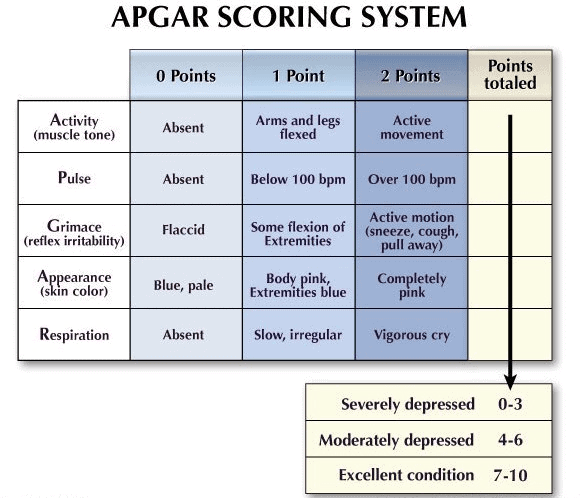
When a baby is born, one of the first things that medical professionals will do is perform an assessment known as the APGAR test. This test, which is performed at one, five and ten minutes of life, is a quick way to determine the baby’s health and if they are in need of resuscitation.
A doctor, nurse, or midwife will evaluate the baby based on 5 categories and assign a score of between 0 and 2 for each category. The highest possible APGAR score is 10. An infant with an APGAR score of 6 or below typically requires immediate medical attention.
Importantly, a low APGAR score does not mean that your baby will have a disability or long-term negative effects. Instead, it indicates that your baby needs some support to help adjust to the outside world. In some cases, a low APGAR score is a sign that a baby has suffered a birth injury.
Quick Information about APGAR Tests
- Criteria of the APGAR test
- How is the APGAR test scored?
- Meaning of a low APGAR score?
- Causes of low APGAR scores
- What parents need to know about APGAR results
- Do APGAR scores predict outcomes?
- Additional information about APGAR tests
What Is an APGAR Score?
Although you may not have heard of her, Dr. Virginia Apgar has played a role in the assessment of the well-being of virtually every newborn baby born in Canada, the United States, and elsewhere in the world for the last 65 years. The test is performed to determine if a newborn is having difficulty breathing or is experiencing heart trouble.
The so-called “APGAR score” was developed by Dr. Virginia APGAR over 65 years ago to provide a means by which doctors and nurses could quickly assess the health of a newborn baby and the need for resuscitation. The test has now become a standard part of the labour and delivery process. Your child was almost certainly given an APGAR score when he or she was born.
The Five Criteria of the APGAR Test
There are 5 categories, or criteria, that the health care provider must consider and assign a value. Within each criteria, the healthcare provider must assign a value of 0, 1, or 2. These 5 criteria include:
- Breathing effort
- Heart rate
- Muscle tone
- Reflexes
- Skin colour
The sum of the scores from the 5 criteria equals the APGAR score. Thus, the APGAR score can be anywhere from 0 to 10. The lower the score, the more likely the child requires resuscitation. Generally, anything under a 7 is considered a low APGAR score.
The APGAR score is usually assessed at one and five minutes after birth. If a baby’s APGAR score remains low at the five-minute test, then he or she may be re-tested at 10 minutes.
How Is the APGAR Scored?
The five APGAR criteria are scored as follows:
Color
- Blue or Pale = 0
- Blue at Extremities = 1
- Completely Pink = 2
Heart Rate
- Absent = 0
- Less than 100 beats per minute = 1
- More than 100 beats per minute = 2
Reflex Irritability
- No Response = 0
- Grimace = 1
- Cry or Active Withdrawal = 2
Muscle Tone
- Limp = 0
- Some Flexion = 1
- Active Motion = 2
Respiration
- Absent = 0
- Weak cry or Hypoventilation = 1
- Good crying = 2
So a baby that is born pink, with a heart rate of more than 100 beats/minute, that withdraws from the stimulus, actively moves, and has a strong cry will receive a perfect APGAR score of 10.
Contact Us Today
Contact us today to learn more about how our birth injury lawyers have helped families provide for their children and receive peace of mind.
What Does a Low APGAR Score Mean?
Any APGAR score below 7 indicates that a newborn needs medical attention and may have suffered from insufficient oxygenation during labour and delivery. The lower an APGAR score is, the more assistance that the baby needs to adjust to breathing independently outside of the womb.
As indicated, the APGAR is first scored at 1 minute of age. If the 1-minute APGAR is low, for example at 3 or below, the baby likely requires medical attention and resuscitation. APGAR scores generally increase at 5 and 10 minutes as the baby’s condition improves.
A baby with a low APGAR score may need medical attention such as:
- Physical stimulation to get the heart to beat at a normal, healthy rate (such as drying off a baby vigorously)
- Oxygen delivered via a mask
- Clearing of the airway to help with breathing
In some cases, if the baby shows signs of distress, oxygen deprivation (birth asphyxia), or other serious issues, they may be transferred to the neonatal intensive care unit (NICU) for more specialised care.
Causes of Low APGAR Scores
Low APGAR scores indicate a need for medical intervention. Babies who have been deprived of oxygen may also have a low APGAR score. A number of complications can result in a low APGAR score, including:
- Fetal heart rate monitoring errors
- Maternal medical conditions
- Infections
- Placental abruption
- Preterm or premature birth
- Prolonged labour
- C-section delays
- Umbilical cord problems
- Uterine hyperstimulation during induction of labour
- Uterine rupture
Importantly, a low APGAR score – particularly 1 minute after birth – may simply be a sign that the baby is having trouble adjusting to life outside of the womb. This often happens after a difficult birth, a premature birth, or after a high-risk pregnancy. In many cases, a baby’s APGAR score increases when re-tested at 5 minutes.
What Parents Need to Know about APGAR Scores
If your baby has a low APGAR score, there is no need to panic. A slightly lower score at the 1 minute mark is common, particularly for babies who are born prematurely, after a high-risk pregnancy, through a c-section, or after a complicated labour and delivery.
An APGAR score of 7 to 10 at the 5-minute mark is considered reassuring, while a score of 4 to 6 is “moderately abnormal.” If a baby continues to have a low APGAR score after 5 minutes, then he or she will need increased intervention. Depending on the baby’s symptoms, this may include transferring the newborn to a neonatal intensive care unit for further medical support.
Most doctors do not consider the APGAR score to be a perfect system. It is a subjective test that relies on judgement calls. For example, one doctor or nurse may score a baby at 7, while another scores the same baby at 6. For this reason, the APGAR test is one of several assessments used to evaluate a newborn’s health.
Some medical professionals use a modified scoring system, such as the Combined-APGAR score that describes both the APGAR score and the interventions that a baby has received. This system has a maximum total points of 17, which indicates that a baby has not received any interventions.
APGAR Scores Do Not Predict Outcomes
It is important to remember that the purpose of the APGAR scoring is to assess the health
of the newborn at the time of birth and determine the need for medical intervention. The APGAR score has a very poor predictive value for determining the long-term health of a child. APGAR scores should not be used for any purpose other than the quick, non-invasive assessment of newborn babies.
In other words, if your baby was born with a low APGAR score it does not necessarily mean that your baby is injured. Most children born with low APGAR scores have no long-term or permanent deficits or problems.
On the other hand, just because your baby had a normal APGAR score does not mean that your baby wasn’t injured during labour and delivery. If your baby has been diagnosed with cerebral palsy and you suspect it may have been caused by medical negligence, a careful examination of the neuroimaging, the neonatal records, and the electronic fetal monitor tracing can indicate whether your child likely suffered a birth injury during labour and delivery.
Want More Information?

The members of the Birth Injury Lawyers Alliance wrote this consumer education guide to help parents understand their rights and their child’s rights when faced with an injury caused by medical negligence. This is the only legal guide in Canada written specifically for parents of children injured during childbirth.
The book is available to download on our website for free. If you would like a print copy, the book is for sale on Amazon (all proceeds go to charity), but we will send you a copy at no charge, if you call us, toll-free at 1-800-300-BILA (2452).
*image courtesy of emsworld.com

John McKiggan, QC has represented clients in pediatric and adult injury claims that have resulted in multi-million dollar awards. In recognition of his accomplishments, John has been honoured by his peers, who elected him president of the Atlantic Provinces Trial Lawyers Association. He has also been named Queen’s Counsel, a designation recognizing exceptional professional merit. John has been selected for inclusion in the Best Lawyers in Canada in the field of personal injury law, he is listed in the Canadian Legal Lexpert Directory and has been named a local litigation star by Benchmark Litigation Canada.

